Made with kombu dashi, this authentic Japanese Vegan Miso Soup is filled with silken tofu and wakame, and packed with umami goodness! It’s hands-down the easiest soup anyone can pull off on a busy weeknight.
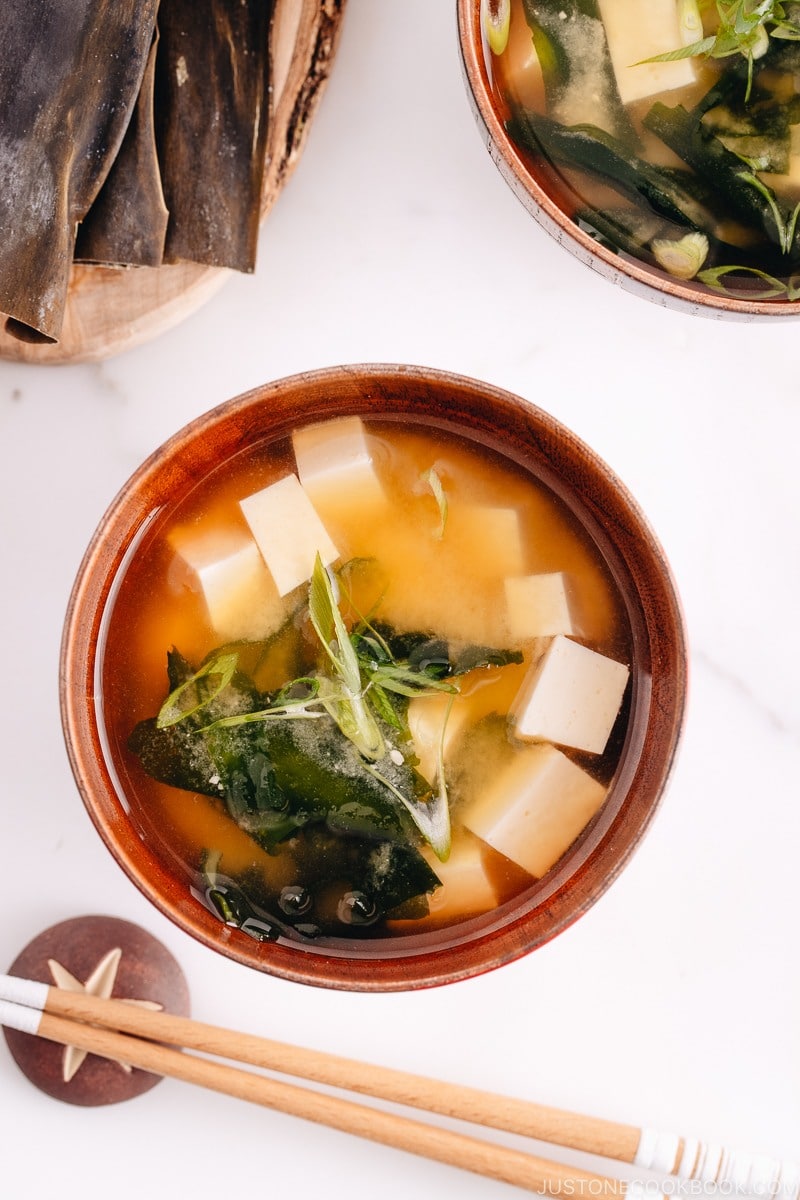
One of the common myths many people have when it comes to miso soup is that it’s not vegan or vegetarian-friendly because dashi, Japanese stock, is included in the soup. They presume that dashi is only made with fish or seafood. And now that’s NOT TRUE.
Japanese stock can be made with different ingredients. Three out of 6 types of dashi are completely vegan/vegetarian because it’s made with kombu (edible kelp), dried shiitake mushrooms, or a combination of both kombu and shiitake mushrooms. You can choose which dashi to use based on your diet requirement or the dish you plan to make.
Today we’ll make vegan-friendly dashi made with kombu, and then we will make miso soup with the kombu dashi. It takes less than 30 minutes to put it all together!
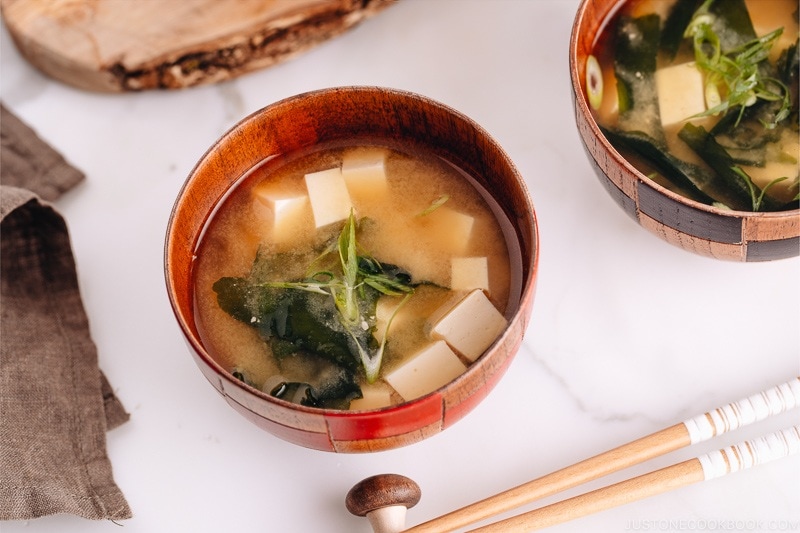
5 Ingredients You Need for Vegan Miso Soup
Miso soup is highly versatile and you can incorporate all sorts of vegetables/ meats/ seafood, but let’s stick to the basic, vegan-friendly ingredients today.
- Kombu (edible kelp)
- Water
- Miso (fermented soybean)
- Tofu (medium-firm or silken)
- Wakame (dried seaweed)
- Optional – green onions/scallions to garnish
Is any of the ingredients above unfamiliar to you? If so, you can read more about kombu, miso, tofu, and wakame on my blog.
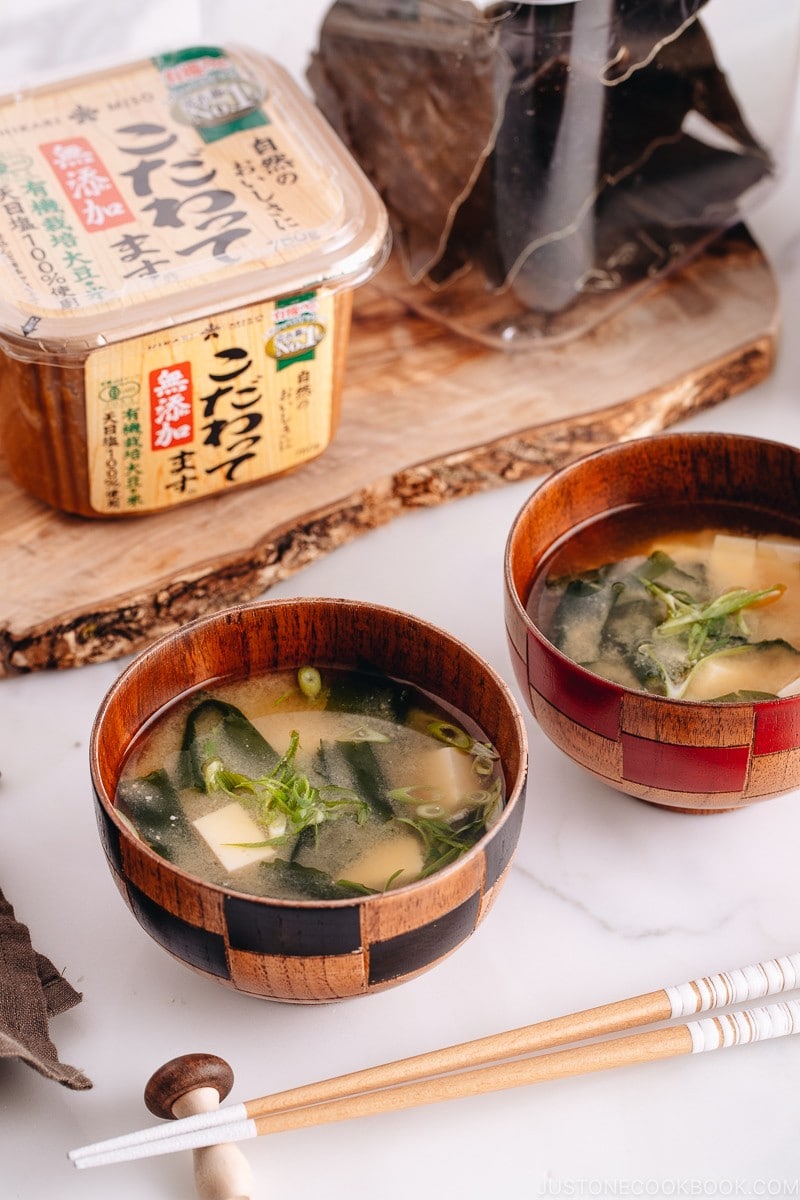
Quick Preview: 3 Steps to Make Vegan Miso Soup
Step 1: Make Kombu Dashi
If you had never made miso soup before, you may get intimidated when you hear the word dashi.
Well, don’t be! Kombu dashi is the easiest stock to make in the world. You can even extract the umami flavor by steeping the kombu in the water while you’re asleep (overnight). It’s perfect for busy (and lazy) home cooks like me.
Today we’re speeding up the process by slowly steeping the kombu in the water on the stovetop so you don’t have to wait overnight.
If you had never seen or bought kombu before, you can purchase it easily in Japanese and Korean grocery stores (or maybe general Asian grocery stores). Sometimes your local American grocery stores or co-ops may carry it too. If you have no luck, check out Amazon.
Step 2: Add Miso
You may wonder what type of miso to buy… and we’ll cover that in the next section. At this step, you’re now ready to add miso.
A typical Japanese miso soup bowl holds about 200 ml of liquid. Miso varies in saltiness depends on types and brands; but as a general rule, we add 1 tablespoon (20 g) of miso per one miso soup bowl (200 ml dashi).
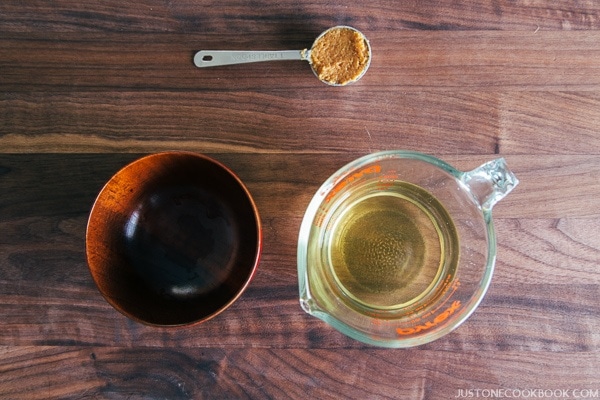
Whenever you add tofu in the miso soup, you ALWAYS put miso first, then tofu. That way, you don’t accidentally break the fragile silken tofu when dissolving the miso paste in the soup.
If you don’t add tofu at all, miso is always added at the end right before serving. How about adding other vegetables? Please hop over to Homemade Miso Soup post where I explain how you cook various ingredients for the miso soup (use kombu dashi).
Step 3: Add Tofu & Wakame
To make the basic miso soup today, we add tofu and wakame seaweed. You may see Japanese people cut the tofu on their palm (for convenience), but if you are not comfortable, just use your cutting board and carefully transfer the tofu into the soup.
The proper way to rehydrate dried wakame is to soak it in water. Wakame is still salty, so it’s best to rehydrate in water, squeeze the water out, and then add into your miso soup bowl. Why not directly to the miso soup in the pot? When wakame stays in the water for a long time, it loses its texture and color. No time for extra step? You can just add wakame into the miso soup (although it’s not a proper method).
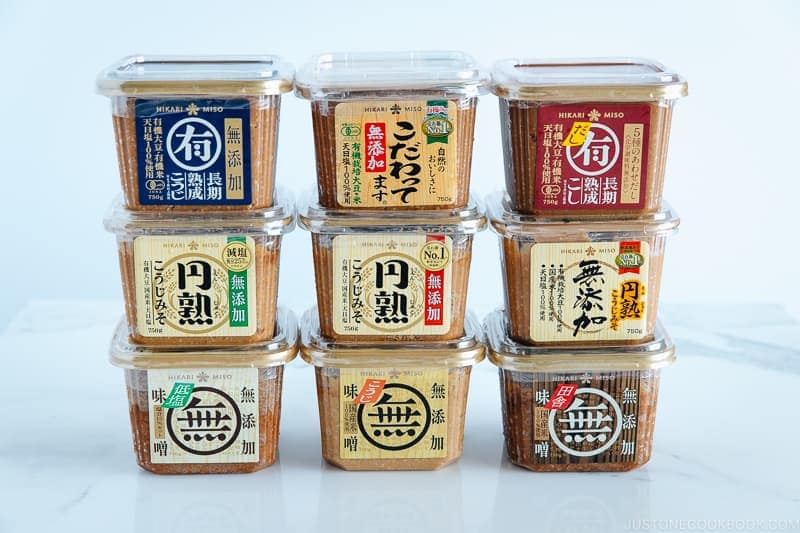
How Do You Decide on What Types of Miso Paste to Buy?
That’s probably one of the most frequently asked questions I received when it comes to miso. It is similar to a question like “what type of cheese should I buy?” All different types of cheeses are still cheese, yet each one is so different from one to another. The verdict is it really comes down to one’s preference. Same thing for miso.
Although you can read all about miso to be familiar with different types of miso, you may want to know one thing: WHICH miso do I like most?
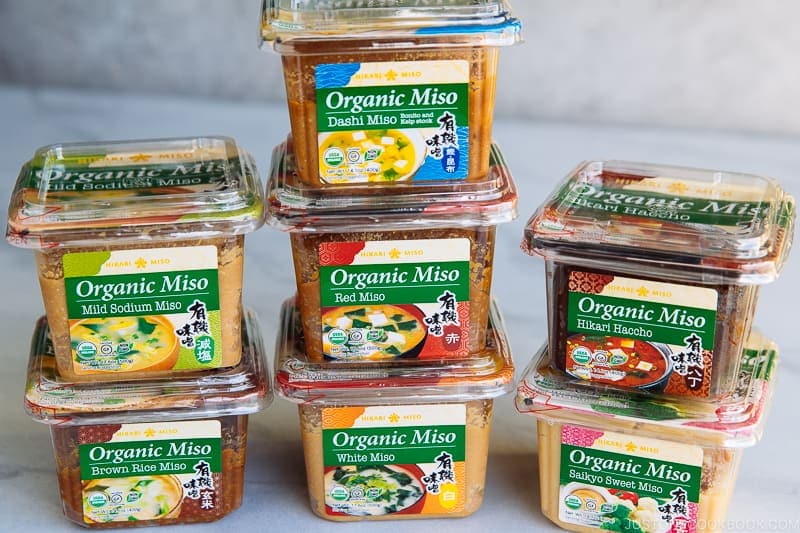
I got the answer for you! After trying out all different types of miso from Japanese grocery stores when I first came to the U.S., I have concluded that this Kodawattemasu by Hikari Miso® is by far my favorite! And now after over a decade of using it in my kitchen, I get to work with this company to share the miso I love (Isn’t it amazing?).
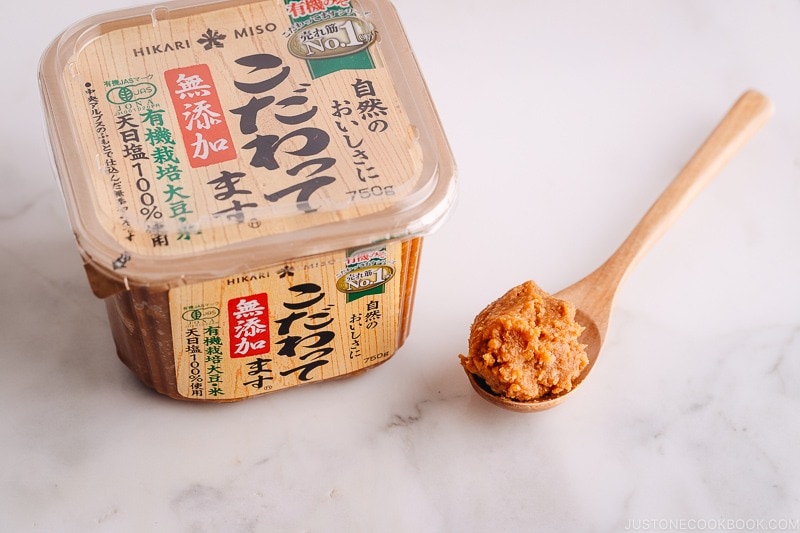
This slow-aged red koji miso is actually the #1 selling miso from Hikari Miso®. It is free of additives and preservatives, is made of organic soybeans and rice, and has a rich and mature flavor with the full-bodied umami of soybeans and the sweetness of rice.
Where you can buy Kodawattemasu by Hikari Miso®:
- Japanese grocery stores (Nijiya, Mitsuwa, Marukai, local mom-pop shops, etc)
- Asian grocery stores (including Chinese/Korean grocery stores)
On a side note, “Kodawattemasu” (こだわってます) in Japanese means “I’m particular (about the quality of miso and the miso-making process).” It may be hard to memorize, so just remember the green label with No.1 on the package!
As a staple of a Japanese meal, I have shared many versions of miso soup on Just One Cookbook. We never get bored of it because it’s easy, pack with good-for-your-gut probiotics, and the most delicious soup to incorporates seasonal ingredients. I hope you enjoy it too!
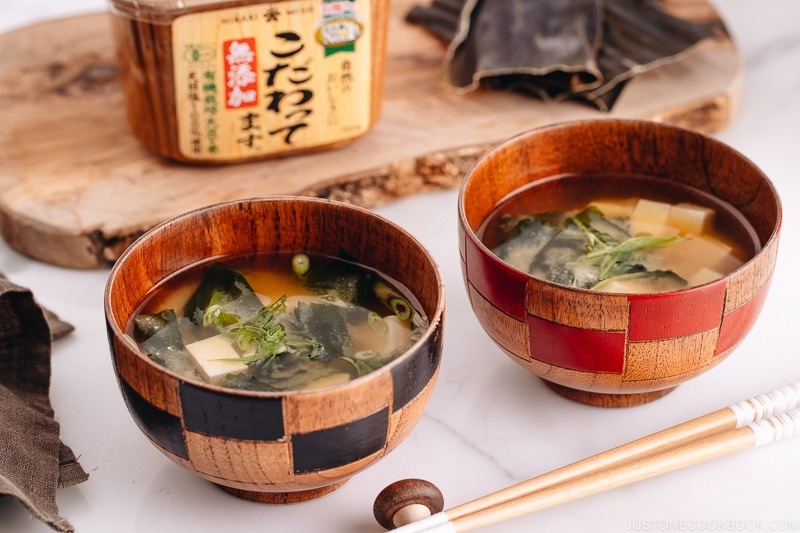
Wish to learn more about Japanese cooking? Sign up for our free newsletter to receive cooking tips & recipe updates! And stay in touch with me on Facebook, Pinterest, YouTube, and Instagram.
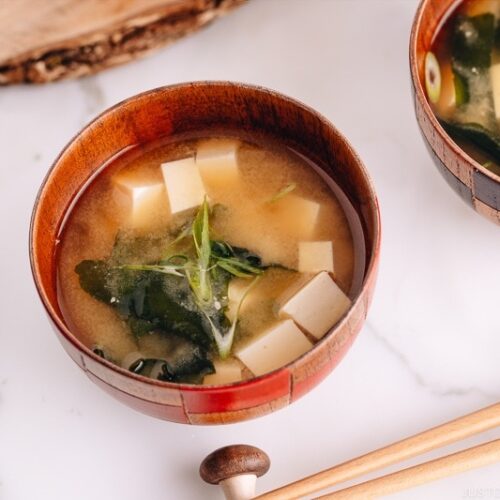
Vegan Miso Soup
Ingredients
For the Kombu Dashi
- 4 cups water
- 1 piece kombu (dried kelp) (0.4 oz, 10 g; 4 x 4 inches, 10 x 10 cm per piece; add more for stronger flavor)
For the Miso Soup
- 1 Tbsp dried wakame seaweed
- 2 green onions/scallions
- 7 oz soft/silken tofu (kinugoshi dofu) (½ package)
- 5 Tbsp miso
Instructions
- Gather all the ingredients.

To Make the Kombu Dashi
- Put 1 piece kombu (dried kelp) in 4 cups water and let it steep for 20 minutes, or as long as you can (maximum overnight).

- Transfer the kombu and water to a pot. Bring it to near boiling point on medium heat. If you didn’t steep for a long time at Step 1, it’s good to slowly bring the kombu water to near boiling on low heat. Once the bubbles start to appear and it looks like almost boiling, remove the kombu and turn off the heat. If you leave the kombu in the water, the kombu dashi can become bitter. So, it’s usually recommended to take it out. Use this used kombu to make Simmered Kombu or Homemade Furikake (Rice Seasoning).

To Prepare the Add-ins and Garnish
- Rehydrate 1 Tbsp dried wakame seaweed in water for 5 minutes. Squeeze the water out and divide the wakame among the individual miso soup bowls.

- Cut 2 green onions/scallions into small pieces (diagonally—optional) and set aside in a small bowl.

- Set the miso soup bowls and green onion aside for now.

To Add the Miso
- A typical Japanese miso soup bowl holds about 200 ml of liquid. Miso varies in saltiness depends on types and brands; but as a general rule, we add 1 tablespoon (20 g) of miso per one miso soup bowl (200 ml dashi). I use a miso muddler (one side measures 1 Tbsp, the other side 2 Tbsp). For this recipe, I use roughly 5 Tbsp miso. Tip: When you add the tofu, you may want to add an extra tablespoon (that’s why I add 5 Tbsp total) because tofu contains additional moisture which dilutes the miso soup.

- When you add the miso, turn off the heat (NEVER let miso soup boil). Scoop some dashi/soup into your ladle and let the miso dissolve in the ladle first using chopsticks or a whisk. Tip: Do not directly drop miso into the soup because you may end up with undissolved chunks of miso left in the soup. It’s very important to taste to check the saltiness.

To Add the Tofu
- Cut 7 oz soft/silken tofu (kinugoshi dofu) into small cubes and add to the miso soup. (Please use a cutting board if you are not used to cutting it on your palm).

- Reheat until hot (but not boiling) and serve. Tip: After adding miso, never let miso soup boil because it will lose aroma and flavor and also kill the probiotics in the miso.

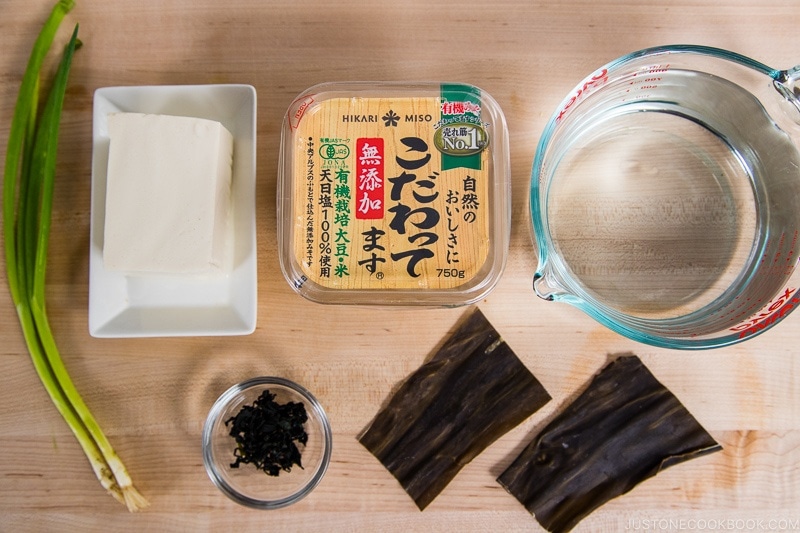
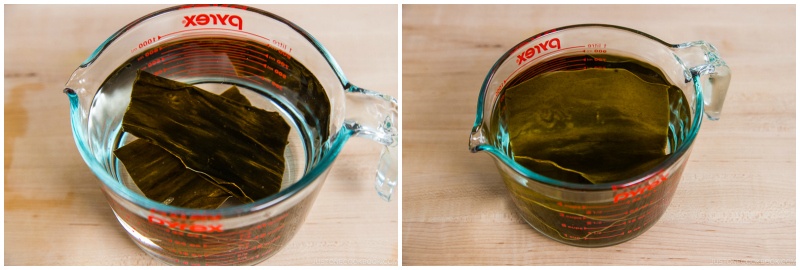



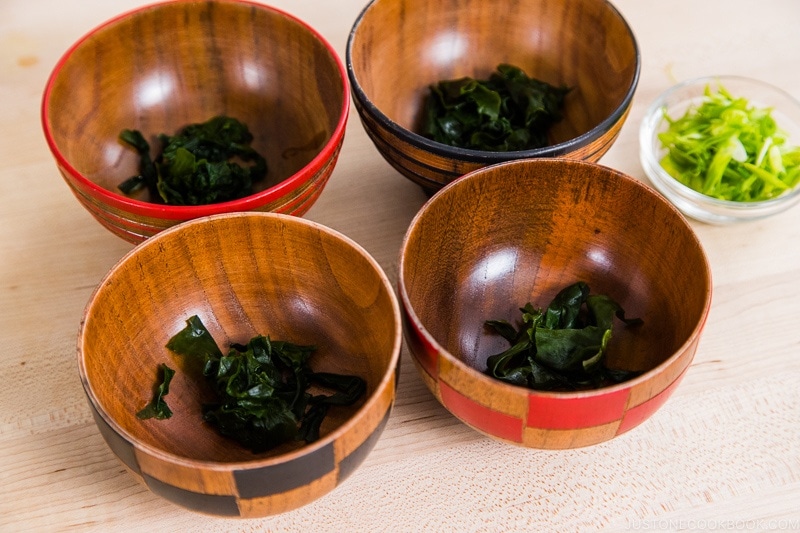
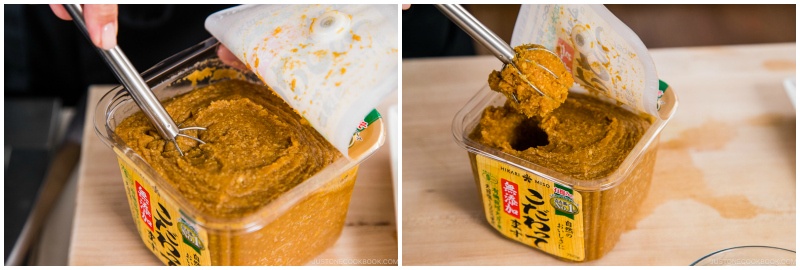
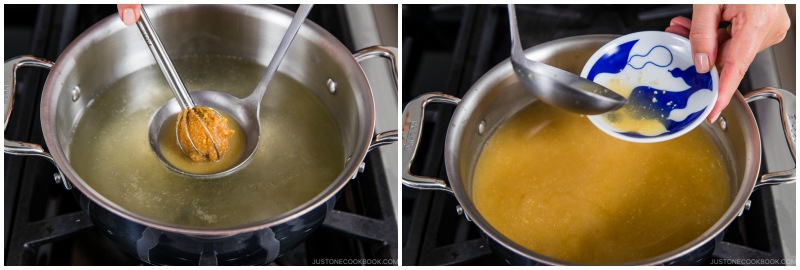

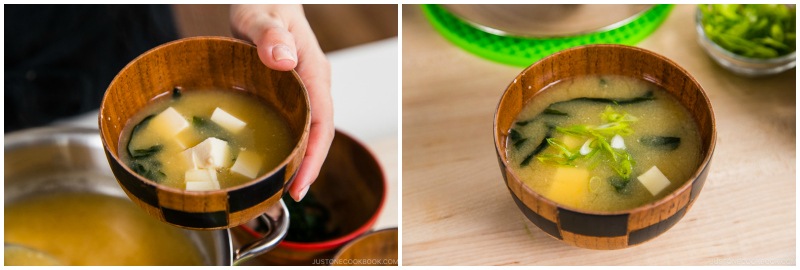










thank you so much! have loved miso soup for 30+ years, can’t believe it took me so long to make it. your recipe was so clear and tasted great (made the vegan version).
Hi Peter! Awesome! We are glad to hear you enjoyed Nami’s recipe!
Thank you for your kind feedback!
Excellent instructions for a vegan who knows very little about Japanese cooking. Made the miso soup and my Japanese neighbor gave me wakame when I was explaining all I had was nori, lol. It was delicious!!!
Hi Susan!
Aww… We are so happy to hear you enjoyed this recipe and instructions!
And glad to hear you had a chance to try Wakame! Yay!😊
Can the simmered kombu be used for other dishes? If so, what type?
Thank you!
Hi Imelda,
How about Kombu Tsukudani (Simmered Kombu) cooked in a sweet and savory sauce?
https://www.justonecookbook.com/simmered-kombu-tsukudani/
You can also use the keyword “Kombu” in the search box on top of the blog to find more recipes! https://www.justonecookbook.com/search/?q=kombu
We hope you can find something you like!☺️
Hello! Thank you for featuring many vegan-friendly recipes on your website. I am eager to try making miso soup 🙂
Usually I cook with extra firm tofu, and press it before using. When using soft tofu for this miso soup, do you press it before adding it to the soup? Or simply cut it right from the package? Thank you!
Hi Ricki,
We are so glad to hear you enjoyed Nami’s vegan-friendly recipes!! Thank you!
When we use soft tofu for miso soup, usually rinse it with clean water and simply cut it. Hope this is helpful!
This miso soup is so good! So simple to make too!
Thank you for sharing this recipe.
Hi Szasza! I’m so glad to hear you enjoyed this recipe. Thank you for your kind feedback. 🙂
Wow thank you for the pro tips! I’ve been trying to make miso soup at home and learnt things the hard way (eg: putting miso into the soup to boil) and wondered why couldn’t I get the same restaurant taste! Going to try your methods. Thank you very much!
Hi Tiffany! I’m glad to hear you figured that out! 🙂 Miso is the last thing added to the soup and make sure not to boil the soup afterward. Hope you enjoy the recipe!
[…] Vegan Miso Soup (with tofu and wakame seaweed) […]
[…] Vegan Miso Soup […]
[…] Vegan Miso Soup […]
[…] Vegan Miso Soup […]
[…] Vegan Miso Soup […]
[…] are perfect for anyone who follows a vegetarian or vegan diet. You’ll love it with this Vegan Miso Soup. Otherwise, you can serve it alongside with another protein dish such as Saba Shioyaki (Grilled […]
[…] carrots are perfect for anyone who follows a vegetarian or vegan diet. You’ll love it with this Vegan Miso Soup. Otherwise, you can serve it alongside with another protein dish such as Saba Shioyaki (Grilled […]
[…] Vegan miso soup […]
[…] Fukuyu Foods (online -premium organic and MSG free Japanese ingredients) […]